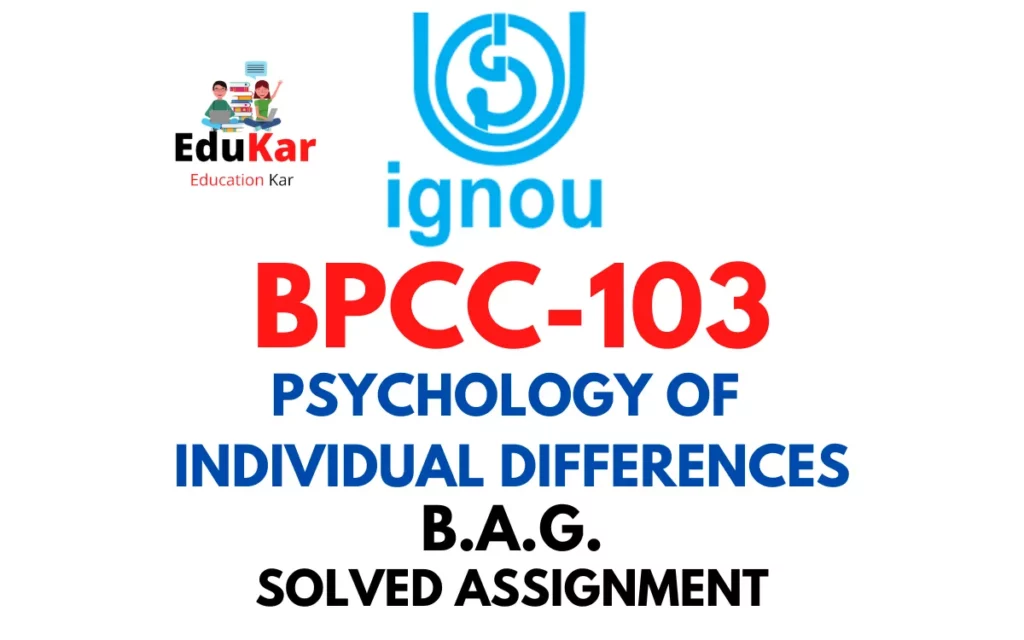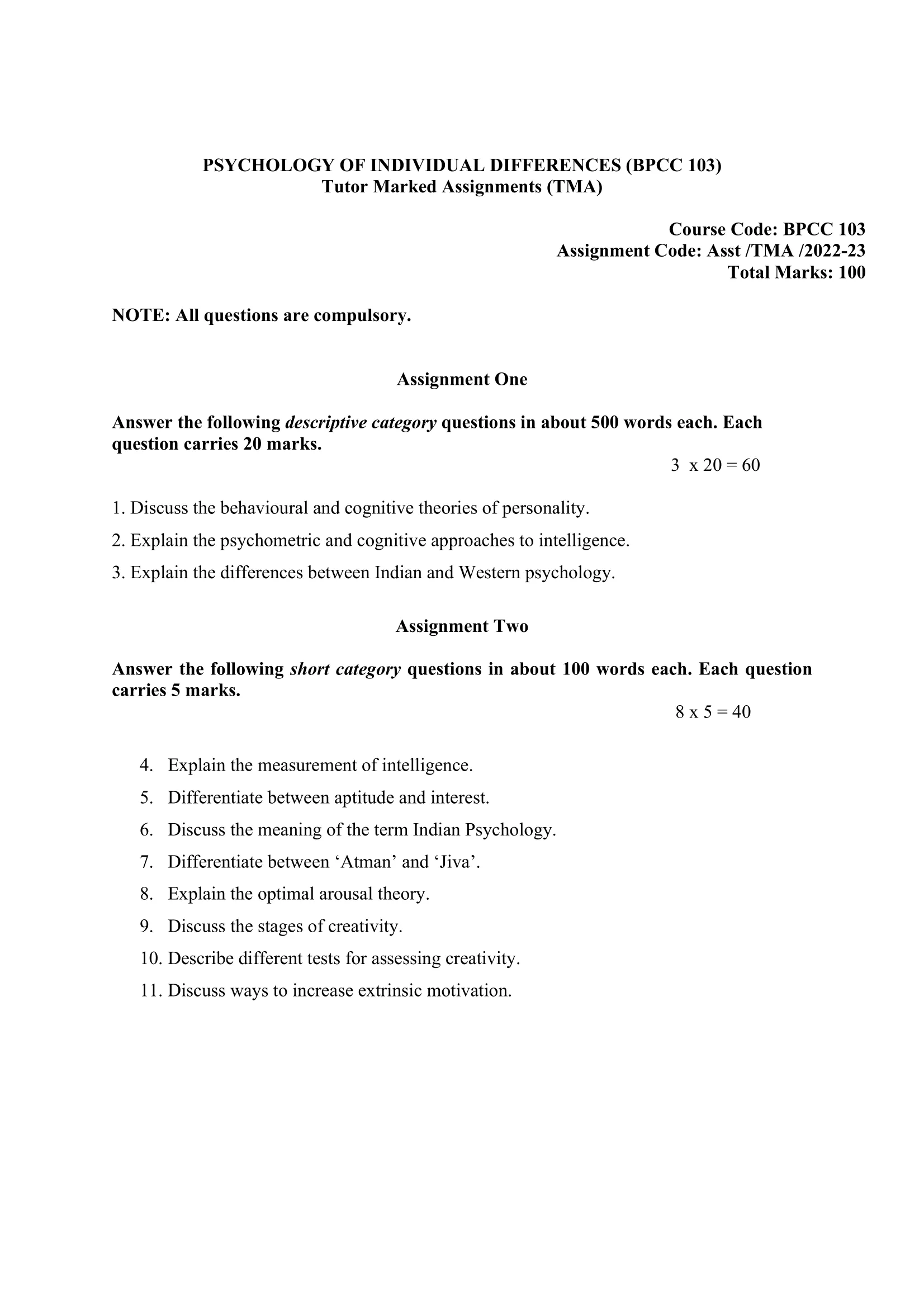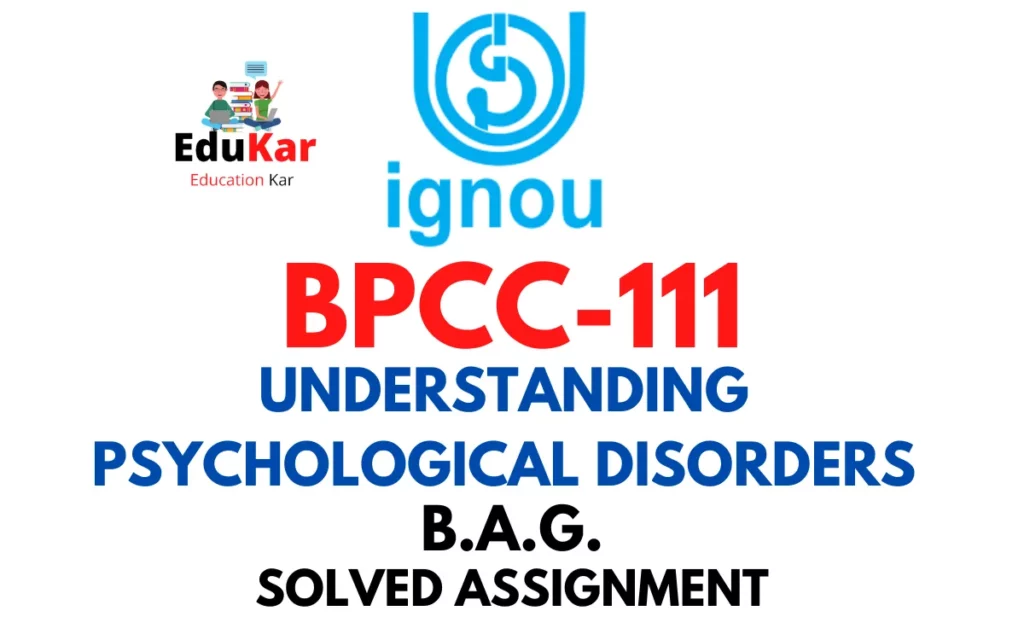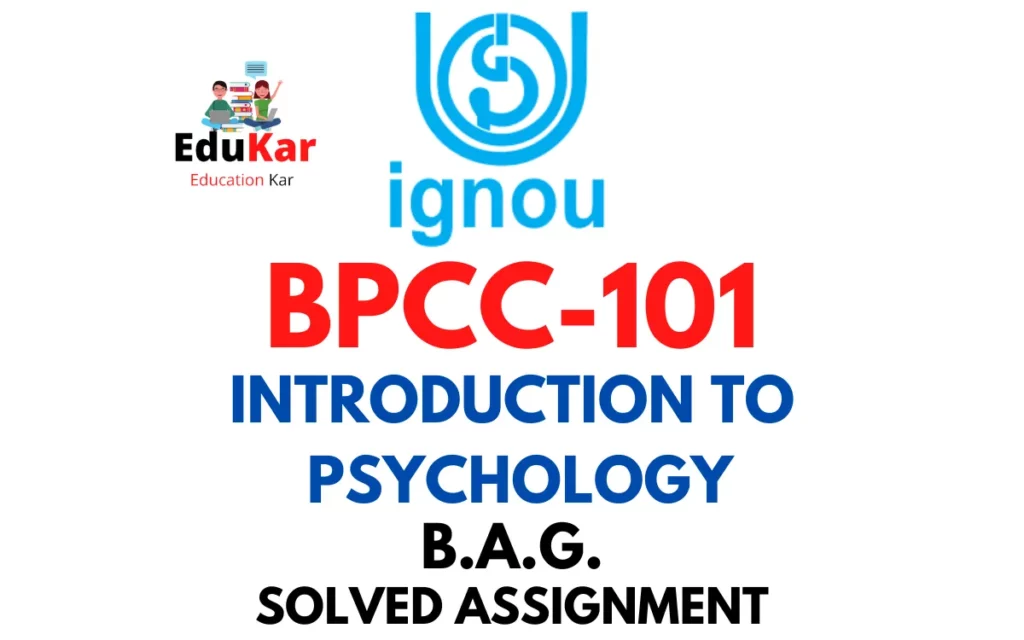Contents
- 1 Assignment One
- 2 Answer the following descriptive category questions in about 500 words each. Eachquestion carries 20 marks.
- 3 1. Discuss the behavioural and cognitive theories of personality.
- 4 2. Explain the psychometric and cognitive approaches to intelligence.
- 5 3. Explain the differences between Indian and Western psychology.
- 6 Assignment Two
- 7 Answer the following short category questions in about 100 words each. Each question carries 5 marks.
- 8 4. Explain the measurement of intelligence.
- 9 5. Differentiate between aptitude and interest.
- 10 6. Discuss the meaning of the term Indian Psychology.
- 11 7. Differentiate between ‘Atman’ and ‘Jiva’.
- 12 8. Explain the optimal arousal theory.
- 13 9. Discuss the stages of creativity.
- 14 10. Describe different tests for assessing creativity.
- 15 11. Discuss ways to increase extrinsic motivation.

| Title | BPCC-103: IGNOU BAG Solved Assignment 2022-2023 |
| University | IGNOU |
| Degree | Bachelor Degree Programme |
| Course Code | BPCC-103 |
| Course Name | PSYCHOLOGY OF INDIVIDUAL DIFFERENCES |
| Programme Name | Bachelor of Arts (General) |
| Programme Code | BAG |
| Total Marks | 100 |
| Year | 2022-2023 |
| Language | English |
| Assignment Code | Asst /TMA /2022-23 |
| Last Date for Submission of Assignment: | For June Examination: 31st April For December Examination: 30th September |

Assignment One
Answer the following descriptive category questions in about 500 words each. Each
question carries 20 marks.
1. Discuss the behavioural and cognitive theories of personality.
Ans: Personality is a complex and multidimensional concept that refers to an individual’s unique pattern of thoughts, feelings, and behaviours that make them distinct from others. Over the years, several theories have been proposed to explain the development of personality. Two prominent theories are the behavioural and cognitive theories of personality. This essay will discuss both theories and how they explain the development of personality.
Behavioural Theory of Personality The behavioural theory of personality emphasizes the role of the environment in shaping an individual’s behaviour. This theory suggests that behaviour is a product of learning that occurs through the interaction of an individual with their environment. According to this theory, personality is not innate but is acquired through a process of reinforcement and punishment. Behaviourists propose that behaviour is determined by the consequences that follow it. If a behaviour is followed by a desirable consequence, the behaviour is likely to be repeated in the future. On the other hand, if a behaviour is followed by an undesirable consequence, the behaviour is less likely to be repeated in the future.
One of the most well-known proponents of the behavioural theory of personality is B.F. Skinner. Skinner’s theory of operant conditioning suggests that behaviour is shaped by its consequences. According to Skinner, positive reinforcement, negative reinforcement, and punishment can be used to modify behaviour. Positive reinforcement is the process of rewarding a behaviour to increase its frequency in the future. Negative reinforcement involves removing an aversive stimulus to increase the frequency of a behaviour. Punishment is the process of presenting an aversive stimulus to decrease the frequency of a behaviour.
Cognitive Theory of Personality The cognitive theory of personality emphasizes the role of an individual’s thoughts and beliefs in shaping their behaviour. This theory suggests that personality is not solely determined by external factors, but also by the individual’s interpretation of those factors. According to the cognitive theory of personality, an individual’s beliefs, attitudes, and values play a crucial role in shaping their behaviour.
Albert Bandura’s social cognitive theory is one of the most well-known cognitive theories of personality. Bandura suggests that individuals learn through observation and imitation of others. He proposed that individuals can develop self-efficacy beliefs, which are their beliefs about their ability to perform a specific task. Self-efficacy beliefs play a significant role in an individual’s behaviour, as individuals are more likely to engage in behaviours that they believe they can perform successfully.
Another aspect of the cognitive theory of personality is the concept of cognitive schemas. A cognitive schema is a mental structure that helps individuals organize and interpret information. Schemas are developed through experience and shape an individual’s perception of the world. For example, an individual who has experienced repeated failures may develop a schema that they are not capable of succeeding, leading to a negative self-concept.
Comparison of Behavioural and Cognitive Theories of Personality While both behavioural and cognitive theories of personality emphasize the role of learning in shaping an individual’s behaviour, there are some key differences between the two theories. Behavioural theory emphasizes the role of environmental factors, while cognitive theory emphasizes the role of internal factors such as beliefs and perceptions. Behavioural theory proposes that behaviour is a product of reinforcement and punishment, while cognitive theory suggests that behaviour is shaped by an individual’s interpretation of their environment.
2. Explain the psychometric and cognitive approaches to intelligence.
Ans: Intelligence is a complex and multidimensional concept that has been the subject of research and debate for many years. Two prominent approaches to understanding intelligence are the psychometric approach and the cognitive approach. This essay will discuss both approaches and how they contribute to our understanding of intelligence.
Psychometric Approach to Intelligence The psychometric approach to intelligence focuses on the measurement of intelligence through standardized tests. Psychometric tests are designed to measure an individual’s cognitive abilities and compare their performance to others of the same age group. The psychometric approach defines intelligence as a measurable, unitary construct that is reflected in an individual’s performance on cognitive tasks.
One of the most well-known psychometric tests of intelligence is the Wechsler Adult Intelligence Scale (WAIS). The WAIS measures an individual’s performance on tasks that assess verbal comprehension, perceptual reasoning, working memory, and processing speed. Scores on the WAIS are standardized to provide an overall intelligence quotient (IQ) score that can be compared to others of the same age group.
The psychometric approach to intelligence has been criticized for its reliance on standardized tests, which may be influenced by cultural and socioeconomic factors. Critics argue that psychometric tests may not accurately measure intelligence in all individuals and may be biased against certain groups.
Cognitive Approach to Intelligence The cognitive approach to intelligence focuses on the processes that underlie intelligent behaviour. This approach proposes that intelligence is a multifaceted construct that involves a range of cognitive processes, such as attention, memory, problem-solving, and decision-making. According to the cognitive approach, intelligence is not a fixed trait, but rather a set of cognitive skills that can be developed through experience and learning.
One of the most well-known cognitive theories of intelligence is Robert Sternberg’s triarchic theory of intelligence. Sternberg proposes that intelligence involves three main components: analytical intelligence, creative intelligence, and practical intelligence. Analytical intelligence involves problem-solving and reasoning skills. Creative intelligence involves the ability to generate new ideas and think outside the box. Practical intelligence involves the ability to apply knowledge to real-world situations.
Another prominent cognitive theory of intelligence is Howard Gardner’s theory of multiple intelligences. Gardner suggests that there are multiple types of intelligence, including linguistic intelligence, logical-mathematical intelligence, spatial intelligence, musical intelligence, bodily-kinesthetic intelligence, interpersonal intelligence, and intrapersonal intelligence.
Comparison of Psychometric and Cognitive Approaches to Intelligence While both the psychometric and cognitive approaches to intelligence provide valuable insights into the nature of intelligence, there are some key differences between the two approaches. The psychometric approach focuses on measuring intelligence through standardized tests, while the cognitive approach focuses on the cognitive processes that underlie intelligent behaviour. The psychometric approach defines intelligence as a unitary construct, while the cognitive approach proposes that there are multiple types of intelligence.
3. Explain the differences between Indian and Western psychology.
Ans: Indian and Western psychology are two distinct systems of psychology that have evolved in different cultural and historical contexts. While both systems share some similarities, such as an interest in understanding the human mind and behaviour, there are also significant differences between them. In this essay, we will explore the differences between Indian and Western psychology.
Historical and Cultural Context One of the most significant differences between Indian and Western psychology is their historical and cultural context. Western psychology has its roots in the European and North American intellectual traditions of the 19th and 20th centuries. It is heavily influenced by the scientific method, which emphasizes empirical observation, data collection, and statistical analysis.
In contrast, Indian psychology has its roots in ancient Indian philosophy and spiritual traditions. Indian psychology is deeply influenced by the concepts of karma, dharma, and moksha, which are central to Hindu, Buddhist, and Jain traditions. These concepts emphasize the cyclical nature of life and the importance of spiritual liberation.
Conceptualization of the Self Another important difference between Indian and Western psychology is their conceptualization of the self. Western psychology tends to view the self as an individual entity that is separate from others and the environment. The self is seen as a stable and consistent entity that can be studied and measured.
In contrast, Indian psychology views the self as a complex and dynamic entity that is inseparable from others and the environment. The self is seen as an interconnected web of relationships that is constantly changing and evolving. The self is also seen as a vehicle for spiritual growth and liberation.
Emphasis on Emotions Western psychology places a strong emphasis on the study of emotions, particularly negative emotions such as anxiety, depression, and anger. Western psychologists often focus on treating these emotions through cognitive-behavioral therapies and other evidence-based approaches.
In contrast, Indian psychology places a strong emphasis on positive emotions such as joy, contentment, and compassion. Indian psychology emphasizes the cultivation of positive emotions through practices such as meditation, yoga, and mindfulness.
Approach to Therapy Western psychology is heavily influenced by the medical model, which views psychological problems as illnesses that can be diagnosed and treated with specific interventions. Western therapists often use a range of evidence-based approaches, such as cognitive-behavioral therapy, psychodynamic therapy, and humanistic therapy.
In contrast, Indian psychology emphasizes a holistic approach to therapy that integrates physical, emotional, and spiritual aspects of the individual. Indian therapies often involve the use of meditation, yoga, and other mind-body practices to promote healing and spiritual growth.
Assignment Two
Answer the following short category questions in about 100 words each. Each question carries 5 marks.
4. Explain the measurement of intelligence.
Ans: Intelligence is a complex concept, and measuring it has been a topic of much debate and controversy over the years. Intelligence tests are commonly used to measure intelligence, and these tests often consist of various cognitive tasks designed to assess different aspects of intelligence, such as verbal, mathematical, and spatial abilities.
One of the most well-known intelligence tests is the Wechsler Adult Intelligence Scale (WAIS), which is designed for adults and consists of various subtests that assess different cognitive abilities. Other commonly used tests include the Stanford-Binet Intelligence Scale and the Kaufman Assessment Battery for Children.
It’s important to note that intelligence tests have limitations, and they can be influenced by various factors, such as cultural differences and educational background. Additionally, intelligence tests may not capture other important aspects of intelligence, such as emotional intelligence or social intelligence. Therefore, while intelligence tests can provide valuable information about cognitive abilities, they should be used in conjunction with other measures to obtain a more complete picture of an individual’s abilities and potential.
5. Differentiate between aptitude and interest.
Ans: Aptitude and interest are two related but distinct concepts that are often used in the context of career planning and development.
Aptitude refers to an individual’s inherent ability or potential to learn or excel at certain skills or tasks. Aptitude is often thought of as an innate quality that an individual possesses, and it can be measured through various tests or assessments. For example, an aptitude test may be used to measure an individual’s ability in a specific area, such as spatial reasoning or mathematical ability.
In contrast, interest refers to an individual’s preferences or likes in terms of activities or topics. An individual’s interests can influence their motivation to engage in certain activities or pursue certain careers. For example, someone with a strong interest in art may be more likely to pursue a career in a related field, such as graphic design or illustration.
While aptitude and interest are related, they are not interchangeable. An individual may have a high aptitude for a certain skill or task, but if they do not have a corresponding interest, they may not be motivated to pursue that activity or career. On the other hand, someone with a strong interest in a certain topic may be motivated to develop the necessary skills and knowledge, even if they do not have an innate aptitude in that area.
6. Discuss the meaning of the term Indian Psychology.
Ans: Indian psychology refers to the diverse and ancient psychological traditions and practices that have originated in the Indian subcontinent. These traditions and practices are based on various philosophical and spiritual systems, such as Hinduism, Buddhism, and Jainism.
Indian psychology differs from Western psychology in several ways. One key difference is that Indian psychology tends to emphasize the interconnectedness of all aspects of human experience, including the physical, mental, and spiritual dimensions. Another difference is that Indian psychology places a greater emphasis on the development of virtues and the cultivation of wisdom and insight, rather than simply the treatment of mental disorders or symptoms.
There are various aspects of Indian psychology, including:
- Yoga: This ancient practice involves physical postures, breath control, and meditation, and is designed to promote physical health, mental clarity, and spiritual growth.
- Ayurveda: This is a traditional system of medicine that emphasizes the importance of balancing the mind, body, and spirit to promote overall health and well-being.
- Buddhism: This religion places a strong emphasis on mindfulness, compassion, and the cultivation of wisdom to overcome suffering and achieve inner peace.
- Hinduism: This religion includes various philosophical and spiritual systems, such as Advaita Vedanta, which emphasizes the unity of all beings and the importance of self-knowledge.
7. Differentiate between ‘Atman’ and ‘Jiva’.
Ans: In Hindu philosophy, Atman and Jiva are two related but distinct concepts that refer to different aspects of the self.
Atman refers to the ultimate and eternal essence of the self, which is said to be unchanging and transcendent. It is sometimes translated as “soul” or “self” and is considered to be identical with the Brahman, the universal consciousness that underlies all of reality. According to Hindu philosophy, the ultimate goal of human existence is to realize the identity of Atman with Brahman, which is known as moksha or liberation.
Jiva, on the other hand, refers to the individual self or personality, which is subject to change and transformation. Jiva is often described as a finite expression of the infinite Atman, and it is said to be bound by karma and the cycle of birth and death. The Jiva is often associated with the individual ego, and is seen as the source of suffering and attachment in the world.
8. Explain the optimal arousal theory.
Ans: The optimal arousal theory is a psychological theory that suggests that individuals are motivated to seek an optimal level of arousal or alertness in order to perform their best in different tasks or situations. This theory proposes that there is a U-shaped relationship between arousal and performance, with both low and high levels of arousal leading to lower performance, and an optimal level of arousal leading to the highest performance.
According to this theory, each individual has an optimal level of arousal that is determined by their biological and psychological makeup, as well as the demands of the task or situation at hand. For example, a challenging task may require a higher level of arousal in order to perform optimally, while a more routine task may require a lower level of arousal.
The optimal arousal theory is often used to explain phenomena such as the Yerkes-Dodson law, which proposes that performance on a task improves with increased arousal up to a point, beyond which performance declines. This theory also has implications for the design of environments and situations that are optimal for learning and performance, as well as for understanding the effects of stress, anxiety, and other factors on performance.
9. Discuss the stages of creativity.
Ans: Creativity is a complex process that involves the generation of novel and valuable ideas or solutions to problems. While there is no one definitive model of the creative process, many scholars and practitioners have proposed a variety of stages or phases that are often involved in the creative process. Here are some of the most common stages of creativity:
- Preparation: This stage involves gathering information, knowledge, and resources that may be relevant to the creative task at hand. This may involve research, brainstorming, or simply immersing oneself in the topic or problem.
- Incubation: This stage involves setting the problem or task aside for a period of time, in order to allow the unconscious mind to work on it. During this stage, the individual may not actively think about the problem or task, but may continue to gather information or engage in other activities.
- Inspiration: This stage involves the sudden insight or breakthrough that leads to the generation of a new and valuable idea or solution. This may occur as a result of a sudden flash of insight or through a more gradual process of exploration and experimentation.
- Evaluation: This stage involves critically evaluating the new idea or solution to determine whether it is feasible, effective, and valuable. This may involve testing, refining, or elaborating on the idea or solution.
- Implementation: This stage involves putting the new idea or solution into action, whether through artistic expression, problem-solving, or other forms of creativity. This may involve feedback and revision, as well as further exploration and experimentation.
It’s important to note that these stages are not necessarily linear, and the creative process may involve moving back and forth between different stages, as well as revisiting earlier stages as new insights and challenges arise. Additionally, the creative process is highly individual, and different people may approach and experience the process in different ways.
10. Describe different tests for assessing creativity.
Ans: Assessing creativity is a challenging task, as it is a complex and multifaceted construct that can be expressed in a variety of ways. However, there are several tests and methods that have been developed to help assess creativity in different domains. Here are some examples:
- Torrance Tests of Creative Thinking: These tests, developed by Ellis Paul Torrance, are some of the most widely used tests for assessing creativity. They consist of a variety of tasks that assess different aspects of creativity, such as fluency, originality, and elaboration.
- Alternative Uses Test: This test asks participants to generate as many uses as possible for a common object, such as a brick or a paperclip. The test assesses divergent thinking, or the ability to generate multiple solutions to a problem.
- Remote Associates Test: This test presents participants with three seemingly unrelated words and asks them to identify a fourth word that is related to all three. The test assesses associative thinking, or the ability to make connections between seemingly disparate ideas.
- Creative Achievement Questionnaire: This questionnaire asks participants to rate their own creative achievements in different domains, such as visual arts, music, or writing. The questionnaire can be used to assess both creative potential and actual creative output.
- Wallach-Kogan Creativity Tests: These tests, developed by Nathan Kogan and Nathan Wallach, consist of a variety of tasks that assess different aspects of creativity, such as fluency, flexibility, and originality.
- Consensual Assessment Technique: This technique involves having a group of experts rate the creativity of a given product, idea, or performance. The experts may use criteria such as originality, usefulness, and aesthetic appeal to make their judgments.
It’s important to note that no single test or method can fully capture the complexity and diversity of creativity, and that multiple measures may be needed to obtain a comprehensive assessment of an individual’s creativity. Additionally, creativity is a highly individual and context-dependent construct, and different tests may be more appropriate for different populations or domains.
11. Discuss ways to increase extrinsic motivation.
Ans: Extrinsic motivation refers to motivation that is driven by external rewards or punishments, such as money, grades, or social recognition. While extrinsic motivation can be effective in certain contexts, such as in the workplace or in educational settings, it is often seen as less sustainable and less fulfilling than intrinsic motivation, or motivation that comes from within. However, there are several ways that extrinsic motivation can be increased. Here are a few examples:
- Provide rewards or incentives: One of the most straightforward ways to increase extrinsic motivation is to provide rewards or incentives for desired behavior or performance. This might include bonuses, prizes, or other forms of recognition.
- Provide clear expectations: When individuals have a clear understanding of what is expected of them, they are more likely to be motivated to meet those expectations. Clear goals, objectives, and performance metrics can help to increase extrinsic motivation.
- Use feedback and recognition: Providing regular feedback and recognition for desired behavior or performance can help to increase extrinsic motivation. This might include public recognition, positive feedback from supervisors or peers, or other forms of acknowledgement.
- Offer training and development opportunities: Providing opportunities for training, skill development, and career advancement can be a powerful motivator for individuals who are looking to improve their professional or personal prospects.
- Use competitive environments: Competition can be a strong motivator for many individuals. Creating a competitive environment, such as through games, contests, or other forms of structured competition, can help to increase extrinsic motivation.
It’s important to note that while extrinsic motivation can be effective in the short term, it is often less sustainable and less fulfilling than intrinsic motivation, which comes from within. Therefore, it’s important to also focus on developing intrinsic motivation through activities that are inherently rewarding, such as hobbies, creative pursuits, or meaningful work.
How to Download BPCC-103 Solved Assignment?
You can download it from the www.edukar.in, they have a big database for all the IGNOU solved assignments.
Is the BPCC-103 Solved Assignment Free?
Yes this is absolutely free to download the solved assignment from www.edukar.in
What is the last submission date for BPCC-103 Solved Assignment?
For June Examination: 31st April, For December Examination: 30th October












![[Solved Assignment] BPCS 185-DEVELOPING EMOTIONAL COMPETENCE (IGNOU-BAG) 2022-2023 [Solved Assignment] BPCS 185-DEVELOPING EMOTIONAL COMPETENCE (IGNOU-BAG) 2022-2023](https://edukar.in/wp-content/plugins/contextual-related-posts/default.png)



